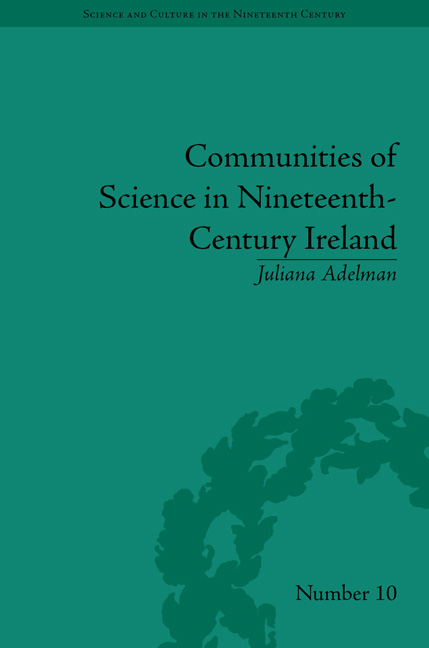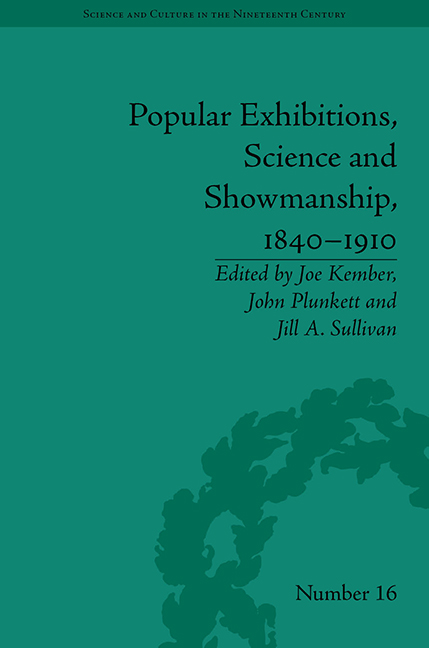Refine search
Actions for selected content:
10306 results in History of science: general interest

Communities of Science in Nineteenth-Century Ireland
-
- Published by:
- Pickering & Chatto
- Published online:
- 05 December 2014
-
- Book
- Export citation
3 - Optical Shattering: Percival Lowell, Mars and Authorities of Vision
- from Part II - Large
-
- Book:
- Vision, Science and Literature, 1870–1920
- Published by:
- Pickering & Chatto
- Published online:
- 05 December 2014, pp 57-88
-
- Chapter
- Export citation
List of Figures and Tables
-
- Book:
- Domesticating Electricity
- Published by:
- Pickering & Chatto
- Published online:
- 05 December 2014, pp ix-x
-
- Chapter
- Export citation
7 - Estate Arboretums
-
- Book:
- The British Arboretum
- Published by:
- Pickering & Chatto
- Published online:
- 05 December 2014, pp 155-184
-
- Chapter
- Export citation
Works Cited
-
- Book:
- Regionalizing Science
- Published by:
- Pickering & Chatto
- Published online:
- 05 December 2014, pp 217-236
-
- Chapter
- Export citation

Popular Exhibitions, Science and Showmanship, 1840–1910
-
- Published by:
- Pickering & Chatto
- Published online:
- 05 December 2014
-
- Book
- Export citation
4 - Watt's Chemistry of Heat
- from II - Realities
-
- Book:
- James Watt, Chemist
- Published by:
- Pickering & Chatto
- Published online:
- 05 December 2014, pp 85-124
-
- Chapter
- Export citation
Notes
-
- Book:
- Natural History Societies and Civic Culture in Victorian Scotland
- Published by:
- Pickering & Chatto
- Published online:
- 05 December 2014, pp 183-222
-
- Chapter
- Export citation
Frontmatter
-
- Book:
- The Age of Scientific Naturalism
- Published by:
- Pickering & Chatto
- Published online:
- 05 December 2014, pp i-vi
-
- Chapter
- Export citation
List of Figures
-
- Book:
- Astronomy in India, 1784–1876
- Published by:
- Pickering & Chatto
- Published online:
- 05 December 2014, pp xi-xii
-
- Chapter
- Export citation
Acknowledgements
-
- Book:
- Uncommon Contexts
- Published by:
- Pickering & Chatto
- Published online:
- 05 December 2014, pp ix-x
-
- Chapter
- Export citation
Introduction
-
-
- Book:
- Toxicants, Health and Regulation since 1945
- Published by:
- Pickering & Chatto
- Published online:
- 05 December 2014, pp 1-24
-
- Chapter
- Export citation
1 - Understanding the Domestication of Electricity
-
- Book:
- Domesticating Electricity
- Published by:
- Pickering & Chatto
- Published online:
- 05 December 2014, pp 9-36
-
- Chapter
- Export citation
6 - The ‘Mythical’ and the ‘Historical’ Newton
-
- Book:
- Recreating Newton
- Published by:
- Pickering & Chatto
- Published online:
- 05 December 2014, pp 159-186
-
- Chapter
- Export citation

Brewing Science, Technology and Print, 1700–1880
-
- Published by:
- Pickering & Chatto
- Published online:
- 05 December 2014
-
- Book
- Export citation

Domesticating Electricity
- Technology, Uncertainty and Gender, 1880–1914
-
- Published by:
- Pickering & Chatto
- Published online:
- 05 December 2014
-
- Book
- Export citation
List of Contributors
-
- Book:
- Uncommon Contexts
- Published by:
- Pickering & Chatto
- Published online:
- 05 December 2014, pp xi-xii
-
- Chapter
- Export citation
Part IV - Future
-
- Book:
- Vision, Science and Literature, 1870–1920
- Published by:
- Pickering & Chatto
- Published online:
- 05 December 2014, pp -
-
- Chapter
- Export citation
Works Cited
-
- Book:
- James Watt, Chemist
- Published by:
- Pickering & Chatto
- Published online:
- 05 December 2014, pp 217-234
-
- Chapter
- Export citation
3 - Darwin in Context: Science Against Slavery
-
- Book:
- Until Darwin, Science, Human Variety and the Origins of Race
- Published by:
- Pickering & Chatto
- Published online:
- 05 December 2014, pp 99-148
-
- Chapter
- Export citation
